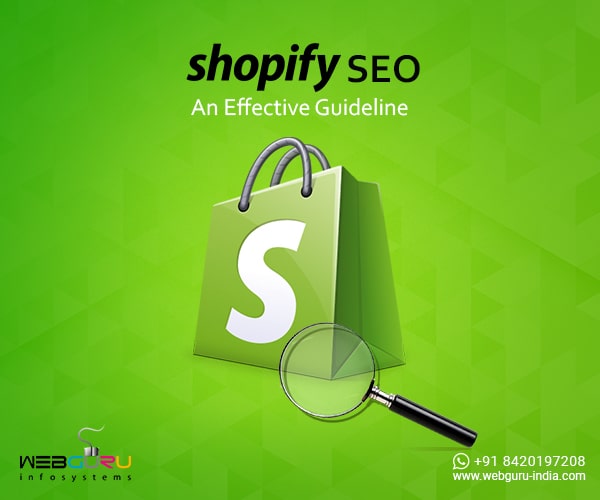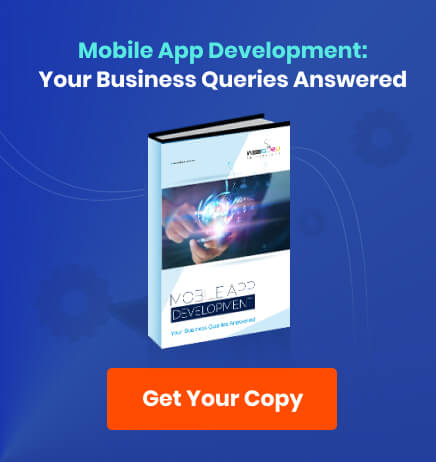Home Blog Digital Marketing Services Shopify SEO: An Effective Guideline
Shopify SEO: An Effective Guideline
- 24 Aug / 2020
- 3,938 views

With over 820,000 stores built on Shopify (source: Shopify), this is one of the most reliable eCommerce platforms these days. However, only building an e-store is not enough to drive traffic and boost sales unless you optimize it properly. The age-old concept of “you just have to build, their work is to come” is simply not working anymore! Today’s competitive digital age demands you to put a continuous effort to draw shoppers and retain them until conversions.
And all these start with Search Engine Optimization (SEO). It can give you a high rank on the search engines to drive higher visibility and more traffic to your store. The result? An increased brand awareness and sales.
While SEO for business websites mainly relies on keywords, it takes more than scattering some keywords here and there in your Shopify store content to improve the site rank. Sounds complicated? Relax, we will walk you through the solution below. Keep reading, then.
Updated SEO Guide for Shopify Store
- Security Simplify Site StructureThe last thing you want is to confuse your users with complicated functionalities. If you want them to spend some time on your store and browse items, you must simplify site navigation. Don’t go overboard with too many subcategories.Remember, a simple site structure makes it easier for the users as well as the search engines to crawl your site and all the web pages. Make sure that users can reach the product pages from the home page in no more than three clicks. Also, include a search bar on your store so that people can instantly find out what they are looking for.Does it impact SEO? Not directly, but user experience does impact SEO ranking. We will discuss this in detail later.Other than the product pages, include an “About Us” page and “Contact” page to enhance reliability.
- Research Rank-Worthy KeywordsSEO is incomplete without keyword research. Before hunting keywords, point out the topics that your service covers or the customers search with. This will also help you to find LSI keywords for your page.LSI or Latent Semantic Indexing keywords are conceptually related terms that enable search engines to understand the content on the page. For instance, if your store features coffee on one web page, consider “instant coffee”, “filter”, “brew”, “cold”, “grind” etc. words as LSI keywords. As you can well understand, these are not synonyms to coffee but help search engines to figure out the overall topic of the page.Google autocomplete or Amazon autocomplete feature can help you find out terms related to the products you sell. If you want to use specific tools, try Ubersuggest, Keyword Tool, LSIKeywords.com, or LSIGraph.Another crucial thing to bear in mind is long-tail keywords. While LSI keywords are semantically related words, long-tail ones are simply the lengthened version of a keyword that searchers often use. Take for example, your store features backpacks. Now, you can use “blue backpack for girls” as a long-tail keyword. Remember, the longer the keyword, the more specific it is. This means lower competition and usually, higher conversion rates. You may use Keyword Tool Dominator (KTD) to automate keyword research. It’ll enable you to get a closer look at the huge autocomplete database from Amazon, Google, Bing, Walmart, eBay, and YouTube.Keyword research demands you to put yourself in the customers’ shoes. Here’re a few ways recommended by top SEO agency India professionals to find inspirations for keywords:
- The keywords your competitors are targeting
- Pay attention to Amazon and other major eCommerce sites to check the tags they are using for similar products that you sell.
- Google AdWords
- Keep an eye on social media hashtags
- “Searches Related to” section at the bottom of Google search result page
- Optimize the PagesNow that you are done researching the keywords, it’s time to optimize the web pages. Here’s a step by step guide to optimize the pages.#Title tag optimization for categories Optimizing a category page demands you to use keywords in a consistent manner. Check the following example for better understanding:Keyword 1 – Shop for Keyword 2 – Your Store Name
Example – Cosmetics – Shop for cosmetics online – XYZ store
#Product Pages
Next on, you have to write titles and meta descriptions for the products. Also, write well-descriptive content for the pages and include your target keywords in the page content without affecting readability.
Further, SEO professionals recommend you to optimize alt text for the images. This is a great SEO practice but ensure that the keywords fit naturally.
- BacklinkingAccording to the experts at any reputed internet marketing agency India, backlinks indicate the community value of your store. Here are some pro tips to get links to your store.
- Influencers – Reach out to the influencers to generate content and links. They have greater reach and can improve your audience base.
- Manufacturer Links – If you sell products made by reputed companies you may email them to ask if they can link to your store.
- Content Marketing – This is the ideal place for backlinks. Create engaging content to improve brand awareness and earn more backlinks. We will discuss more on this later.
- Mentions – Sometimes, people may mention your e-store without linking to it. You may use mention.com to find out such mentions. Then send an email to request them to link to your site.
- Structured DataShopify comes with various SEO-friendly features and one of these is structured data. We will categorize it in three sections – Product structured data, Article structured data, and BreadcrumbList structured data. Let’s quickly proceed then.#Product Structured Data Shopify themes are equipped with product markup which offers key information like the product’s name, price, and description to Google. Expand the data to collection pages as well. For that, you have to add the Product structured data to outline every distinct product link in a product listing page.#BreadcrumbList Structured Data
Breadcrumbs are significant to any eCommerce website as these provide user-friendly internal links to help the users understand where they are at in the hierarchy of a website. These actually take filters into account and act as navigation menus. For example, a breadcrumb trail structure on a web page for refrigerator can show the following structure:
Home > Electronics > Home Appliances > Refrigerators
Breadcrumbs help search engines to better crawl the site’s structure and its internal links. That’s why adding site breadcrumbs to Shopify store and marking these up with BreadcrumbList structured data is a must.
#Article Structured Data
If you use Shopify blog functionality (which you should for driving more organic traffic to your site), you can use Article structured data. This is a schema type that makes Google understand that your content is more editorial in nature. You may have noticed that Google often showcases content tagged with “Article” structured data on the platforms like Google Discover. Marking your content with such a structured data can increase its chance of getting featured there. This will enhance brand visibility and boost your page traffic.
- Improve User ExperienceWe already mentioned this earlier in brief. User experience is one of the crucial ranking factors these days so ensure that your shop is not deprived of it! Here are a few things to keep an eye on:
- Boost Speed – Optimize the images, use a mobile-friendly theme, remove unnecessary ads to enhance the loading speed of your web application.
- Responsive design – Nowadays, people prefer to browse e-stores on-the-go. That’s why it’s important to ensure that your store looks awesome and perform brilliantly on cross-devices including smartphones, tablets, laptops.
- Site Security – Site security plays a crucial role in improving the visitors’ and search engine’s confidence on your site. That’s why you must obtain an SSL (Secure Sockets Layer) certificate for your e-store. Here’s a cool stat: the green padlock on the URL can increase sales up to 40% (source: LeaderSSL)! Still wondering why to get one?
- Crawling & IndexingCrawling and indexing is an important part in eCommerce SEO. Here are a few SEO items unique to a Shopify store.#RedirectsIf your store has old or expired pages or any content that doesn’t exist anymore, implement redirects so as not to frustrate the users. Execute this by going to Online Store > Navigation > URL Redirects.#Robots.txt File
Robots.txt is a text file that webmasters create in order to instruct search engine robots how to crawl pages on a site. This is a part of the web standards (Robots Exclusion Protocol or REP) that controls how robots access and index web content and serve the content to the users.
The fact that you cannot directly adjust the robot.txt file on the Shopify sites can be quite limiting. This is the easiest way to regulate Google’s crawl of your site. However, Shopify creates a few default disallow commands. Some of the sections of your site that Shopify disallows crawling include:
- Admin area
- Orders
- Shopping cart
- Checkout
- Internal search
- Policy page
You can try other methods like “nofollow” or canonical tags to somewhat control Google’s crawling.
#Noindex tag
You can add noindex tag to instruct search engines not to index a web page on the SERP (Search Engine Result Page). You may want to exclude a specific page or an entire template from the index. Due to the unavailability of robots.txt file, you mainly have to rely on this.
- Remove Duplicate Page / ContentContent duplication is a big no-no in SEO best practices. Make sure that duplicate or similar content doesn’t exist under two distinct URLs on your website. This confuses search engines and in turn, you can be the prey of keyword cannibalization. Also, link juice will be split between the two pages.That’s why experienced SEO services provider unanimously recommend you to remove one of the pages and curate an extensive content including all the information. The same theory applies to duplicate collection pages.A duplicate collection page (say, a URL with “?page=1” for the first collection page in a specific series) will usually feature the same content as the master non-parameterized URL. Therefore, adjust the internal linking structure to ensure that the first paginated result directs to the canonical page.The same holds true for a product variant page. Same product with slight variations (say different coloured) may create multiple pages. However, some opine that having variant product URLs may benefit SEO as these will optimize & index the pages for specific terms. Give this blog a read to learn SEO best practices for product variants.Remember, page duplication can be a major trouble in an eCommerce web application. Too many unnecessary pages will make the store heavy and can even confuse the audience.
- Use Shopify PluginsRaise your hands if you love plugins, we already did!Shopify plugins are highly useful in increasing its core functionalities. Check out the top 3 Shopify SEO plugins:
- Plugin SEO – This app allows you to bulk edit SEO data such as meta tags and descriptions. It also adds Schema markup on the product pages. From fixing broken links and running automatic SEO audit – the app is the best bet for many.
- SEO Booster – The plugin enables you to bulk edit your product pages. It also monitors 404 errors and lets you submit sitemaps easily. It helps the search engines to crawl your site more intelligently.
- Smart SEO – Smart SEO claims to minimize your store optimization time by 80%! This comprehensive tool helps you to generate and optimize meta tags, image alt tags, and structured data.
- Yotpo Reviews – This tool can help you add product reviews to your store and earn rich review stars for your content on the SERP.
Other than these, you can always use Google AdWords, SEMRush tool, and Moz SEO tool for conducting keyword research and analysing the efficacy of your SEO practices.
Wrapping Up
If you use Shopify as your eCommerce platform or planning to use it sometime soon, it’s extremely important to understand how to implement SEO practices on your store. We hope our detailed guideline has offered a deeper insight. Feel free to share your thoughts.

Priyanka Agarwal
An expert digital marketer with vast knowledge in SEO, SMO, and the like, Priyanka Agarwal writes about the latest trends in digital marketing.
3 comments
Leave a Reply

-
1000+
Happy
Clients -
25+
Countries
Served -
19+
Years of
Trust








Thank you for sharing this information. This information is very useful to us.
You have written such a nice content. Thank You for sharing. Waiting for more.
I heartily impressed by your blog and learn more from your article. Thank you so much for sharing with us.